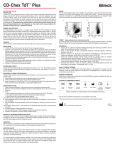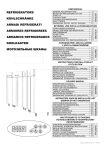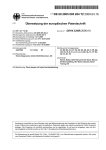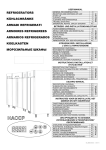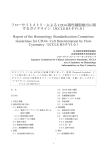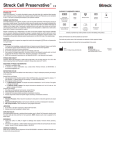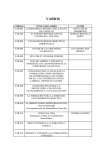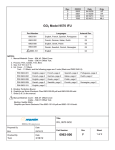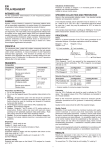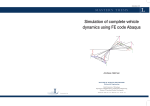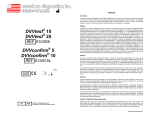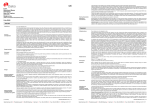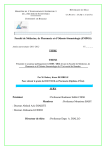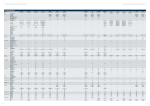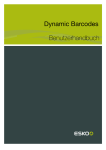Download CD-Chex CD117® Plus
Transcript
CD-Chex CD117 Plus ® INSTRUCTIONS FOR USE INTENDED USE CD-Chex CD117® Plus is intended to be used as a quality control material for evaluating CD117, CD25 and CD71 monoclonal antibody binding by flow cytometry. When these cells are stained with fluorescent antibodies and analyzed by flow cytometry, they provide a reference value for the abnormal cells found in certain types of hematopoietic neoplasms. CD-Chex CD117 Plus is designed for use on BD Biosciences and Beckman Coulter® flow cytometry systems. This product and the markers provided on the assay have not been cleared by the U.S. Food and Drug Administration for In Vitro Diagnostic use. This product and the values provided are For Research Use Only. Not for use in diagnostic procedures. SUMMARY/BACKGROUND CD-Chex CD117 Plus is designed to represent abnormal peripheral blood leukocytes similar to a hematolymphoid neoplastic patient sample1,2,3. CD-Chex CD117 Plus possesses surface CD117, CD25 and CD71 that are detectable with fluorescent monoclonal antibodies by flow cytometry. Abnormal leukocytes are distinguishable from normal leukocytes on the basis of light scatter properties and a low level of CD45 expression. CD-Chex CD117 Plus is a positive procedural assayed control used to monitor reagent staining, erythrocyte lysis, sample preparation, and instrument performance. A. Beckman Coulter® FC 500 BD FACSCalibur™ B. REAGENTS CD-Chex CD117 Plus contains stabilized human blood and cells of human origin in a preservative medium. PRECAUTIONS 1. CD-Chex CD117 Plus is For Research Use Only. 2. All human blood material used to manufacture this product was non-reactive for antigens to Hepatitis B (HBsAg), negative by tests for antibodies to HIV (HIV-1/HIV-2) and Hepatitis C (HCV), non-reactive for HIV-1RNA and HCV RNA by licensed NAT, and non-reactive to Serological Test for Syphilis (STS) using techniques specified by the U.S. Food and Drug Administration. Because no known test method can assure complete absence of human pathogens, this product should be handled with appropriate precautions. 3. This product should not be disposed in general waste, but should be disposed with infectious medical waste. Disposal by incineration is recommended. 4. This product is intended for use as supplied. Adulteration by dilution or addition of any materials to the product vial invalidates the use of the product. 5. CD-Chex CD117 Plus should not be used as a calibrator. STORAGE AND STABILITY CD-Chex CD117 Plus is stable through the expiration date when stored at 2 °C-10 °C. After opening, CD-Chex CD117 Plus is stable throughout the open-vial dating, as indicated on the assay sheet, when stored at 2 °C-10 °C. DO NOT FREEZE. INDICATIONS OF PRODUCT DETERIORATION If CD-Chex CD117 Plus values are not within the expected range on the assay sheet: 1. Review control product package insert, assay and operating procedures of the instrument. 2. Check expiration date of the product vial. Discard outdated products. 3. Clumping of the cell suspension indicates instability or deterioration, in which case the reagent should not be used. 4. Assay an unopened vial of CD-Chex CD117 Plus. If the values are still outside the expected range, contact Streck Technical Services at 800-843-0912 or [email protected]. INSTRUCTIONS FOR USE 1. Follow instrument manufacturer’s instructions for instrument compensation and sample analysis. 2. Remove a vial of the control from refrigerator and warm to room temperature (18 °C-30 °C) for 15 minutes before use. 3. To mix: a. Hold horizontally between palms of the hands and roll the vial back and forth for 20 to 30 seconds. b. Mix by gentle inversion at least 8-10 times until all cells are thoroughly suspended. c. Gently invert the vial 5 times immediately before sampling. Note: Vials stored for an extended period of time may require extra mixing. 4. Aliquot appropriate volume of control reagent into each tube and return to refrigeration to ensure maximum open vial stability. 5. Add recommended monoclonal antibodies according to manufacturer’s instructions to each tube and mix gently. Note: A negative staining control is recommended due to the heterogeneous expression of CD117, CD25 and CD71. 6. Incubate according to antibody manufacturer’s instructions. 7. Add recommended amount of RBC lysing agent according to manufacturer’s instructions. 8. Analyze by flow cytometry by gating the abnormal cells and/or a total leukocyte “Live”4 gate from a CD45/ SSC or FSC/SSC plot. See Figure 1. LIMITATIONS 1. For optimum results, CD117 should be evaluated using a mAb conjugated to fluorochromes other than PerCP-Cy5.5. 2. CD117 evaluated with mAb 95C3 when using lyse other than ammonium chloride will result in sub-optimal recovery. 3. CD25 recovery is reduced when using the Beckman Coulter® mAb B1.49.9 conjugated to FITC. EXPECTED RESULTS The mean values provided are derived from replicate analyses on properly compensated flow cytometers. The assay values are obtained using reagents recommended by each instrument manufacturer. The expected ranges listed represent estimates of variation due to different laboratories’ reagents, instrument performance, maintenance, and operator technique. Use of alternate gating strategies not specified in these instructions may result in values outside the published range. It is recommended that an individual laboratory establish its own control means and ranges that reflect the laboratory’s specific conditions and protocols. These established control means should fall within the published expected ranges. Data collected from interlaboratory quality control programs can be used as a cumulative approach when calculating ranges. GATING The most common gating strategy used in neoplastic cell assessment is to gate on the abnormal cells and then determine the CD marker percent positivity using a negative staining control1-4. Abnormal cells are generally located with either a FSC/SSC plot or a CD45/SSC plot; although other gating strategies can be employed1-4. A less frequently employed method is to gate all of the leukocytes in a “Live”4 gate, then determine the CD marker percent positivity of the white blood cells. FIGURE 1. Gating methods used to obtain CD117, CD25 and CD71 reference values. In CD-Chex CD117 Plus, the abnormal cells (RED OVALS) are CD45dim/FSCheterogeneous/ SSCintermediate. These cells are positioned in the monocyte region of a FSC/SSC plot (A) or in the blast region of a CD45/SSC plot (B). In CD-Chex CD117 Plus, the “Live” gates (BLACK RECTANGLES) are the total leukocytes, which include all of the cells, normal and abnormal, excluding debris. REFERENCES 1. Gorczyca, W. Flow Cytometry in Neoplastic Hematology, Morphologic-Immunophenotypic CorrelationSecond Edition, Informa Healthcare, New York, NY USA, 2010. 2. Cheria, S., Wood, B. Flow Cytometry in Evaluation of Hematopoietic Neoplasms; A Case-Based Approach. CAP Press, Northfield, IL USA, 2012. 3. Nguyen, D., Diamond, L.W., Braylan, R.C. Flow Cytometry in Hematopathology, A Visual Approach to Data Analysis and Interpretation-Second Edition, Humana Press, Totowa, NJ USA, 2007. 4. Clinical and Laboratory Standards Institute H43-A2 Clinical Flow Cytometric Analysis of Neoplastic Hematolymphoid Cells; Approved Guideline - Second Edition. Clinical and Laboratory Standards Institute, Wayne, PA USA, 2009. ADDITIONAL RESOURCES van Dongen, J.J., Lhermitte, L., Böttcher, S., Almeida, J., van der Velden, V.H., Flores-Montero, J., Rawstron, A., Asnafi, V., Lécrevisse, Q., Lucio, P., Mejstrikova, E., Szczepański, T., Kalina, T., de Tute, R., Brüggemann, M., Sedek, L., Cullen, M., Langerak, A.W., Mendonça, A., Macintyre, E., Martin-Ayuso, M., Hrusak, O., Vidriales, M.B., Orfao, A. EuroFlow Consortium. EuroFlow Antibody Panels for Standardized n-Dimensional Flow Cytometric Immunophenotyping of Normal, Reactive and Malignant Leukocytes. Leukemia. 2012 Sep; 26(9):1908-75. Wood, B.L., Arroz, M., Barnett, D., DiGiuseppe, J., Greig, B., Kussick, S.J., Oldaker, T., Shenkin, M., Stone, E., Wallace, P. 2006 Bethesda International Consensus Recommendations on the Immunophenotypic Analysis of Hematolymphoid Neoplasia by Flow Cytometry: Optimal Reagents and Reporting for the Flow Cytometric Diagnosis of Hematopoietic Neoplasia. Cytometry B Clin Cytom. 2007; 72 Suppl 1:S14-22. QUALITY CONTROL PROGRAM Streck offers STATS®, an interlaboratory quality control program, to all customers at no charge. For more information, contact the STATS Department at 800-898-9563 or [email protected]. Additional information can be found at www.streck.com. ORDERING INFORMATION Please call our Customer Service Department toll free 800-228-6090 for assistance. Additional information can be found online at www.streck.com. GLOSSARY OF HARMONIZED SYMBOLS LOT Batch Code REF Biological Risk Catalog Number Use By Manufacturer Consult Instructions For Use Temperature Limitation Glossary of symbols may contain symbols not used in the labeling of this product. See www.streck.com/patents for patents that may be applicable to this product. The brand and product names of the instruments are trademarks of their respective holders. Streck 7002 S. 109 Street Omaha, NE 68128 USA 350622-3 2015-06 MODE D’EMPLOI French (Francąis) USAGE PRÉVU CD-Chex CD117® Plus est destiné à être utilisé comme matériel de contrôle de qualité pour évaluer par cytométrie de flux la fixation des anticorps monoclonaux anti-CD117, anti-CD25 et anti-CD71. Quand ces cellules sont marquées avec des anticorps fluorescents, puis analysées par cytométrie de flux, elles fournissent un niveau de référence pour les cellules anormales qui se trouvent dans certains types de néoplasmes hématopoïétiques. CD-Chex CD117 Plus a été conçu pour être utilisé avec les systèmes de cytométrie de flux de BD Biosciences et Beckman Coulter®. Ce produit et les marqueurs fournis avec le kit de dosage n’ont pas reçu l’autorisation de l’U.S. Food and Drug Administration pour une utilisation diagnostique in vitro. Ce produit et les valeurs fournies sont réservés à la recherche. Utilisation interdite dans les procédures diagnostiques. FENÊTRAGE La stratégie de fenêtrage la plus courante utilisée dans l’évaluation de cellules néoplasiques consiste à fenêtrer les cellules anormales, puis à déterminer le pourcentage de positivité pour le marqueur CD en utilisant un contrôle de coloration négatif.1-4 Les cellules anormales se trouvent généralement avec un cytogramme FSC/SSC ou CD45/SSC, même si d’autres stratégies de fenêtrage peuvent être employées.4-4 Une méthode moins souvent employée consiste à fenêtrer les leucocytes totaux dans une fenêtre « live »4, puis de déterminer le pourcentage de positivité du marqueur CD pour les globules blancs. A. BD FACSCalibur™ Beckman Coulter® FC 500 SOMMAIRE/CONTEXTE CD-Chex CD117 Plus est destiné à représenter des leucocytes anormaux du sang périphérique comme dans un échantillon patient néoplasique hématolymphoïde.1,2,3 CD-Chex CD117 Plus possède des CD117, CD25 et CD71 de surface détectables par des anticorps monoclonaux fluorescents par cytométrie de flux. Les leucocytes anormaux se distinguent des leucocytes normaux sur la base des propriétés de diffusion de la lumière et d’une faible expression de CD45. CD-Chex CD117 Plus est un contrôle positif de dosage qui permet de surveiller la réaction à la coloration, la lyse érythrocytaire, la préparation des échantillons et la performance des instruments. RÉACTIFS CD-Chex CD117 Plus contient du sang humain et des cellules d’origine humaine stabilisés dans un milieu de conservation. PRÉCAUTIONS 1. CD-Chex CD117 Plus est réservé à la recherche. 2. Tout produit sanguin d’origine humaine utilisé pour fabriquer ce produit s’est montré non réactif vis-à-vis des antigènes du virus de l’hépatite B (HBsAg) et négatif aux tests de dépistage d’anticorps anti-VIH (VIH-1/VIH-2) et anti-hépatite C (HCV), non réactif aux dépistages ARN VIH-1 et ARN HCV par TAN sous licence et non réactif au dépistage sérologique de la syphilis (STS) par les techniques spécifiées par la U.S. Food and Drug Administration. Comme aucune méthode de test connue ne peut assurer l’absence totale d’agents pathogènes humains, ce produit doit être manipulé en prenant les précautions appropriées. 3. Ce produit ne doit pas être mis au rebut avec les déchets ordinaires, mais avec les déchets médicaux infectieux. Une élimination par incinération est recommandée. 4. Ce produit doit être utilisé tel qu’il est été fourni. La dilution ou le mélange du produit avec toute autre substance annule son utilisation. 5. CD-Chex CD117 Plus ne doit pas être utilisé comme calibrateur. CONSERVATION ET STABILITÉ Le CD-Chex CD117 Plus est stable jusqu’à la date de péremption lorsqu’il est conservé entre 2 et 10 oC. Après ouverture, CD-Chex CD117 Plus reste stable jusqu’à la date limite indiquée sur la notice de dosage, à condition d’être conservé entre 2 et 10 oC. NE PAS CONGELER. INDICATIONS DE DÉTÉRIORATION DU PRODUIT Si les valeurs du CD-Chex CD117 Plus ne se situent pas dans l’intervalle escompté de la notice de dosage : 1. Lire la notice d’utilisation du produit de contrôle, la procédure de dosage et le mode d’emploi de l’instrument. 2. Vérifier la date de péremption du produit sur le flacon. Jeter les produits périmés. 3. La présence d’agrégats dans la suspension cellulaire indique une instabilité ou une détérioration. Dans ce cas, le réactif ne doit pas être utilisé. 4. Répéter le dosage avec un flacon non ouvert de CD-Chex CD117 Plus. Si les valeurs se situent toujours hors de l’intervalle escompté, appeler le Service technique de Streck au +1 402-691-7510 ou envoyer un courriel à l’adresse suivante : [email protected]. MODE D’EMPLOI 1. Pour la compensation de l’instrument et l’analyse des échantillons, suivre les instructions du fabricant de l’instrument. 2. Retirer un flacon de contrôle du réfrigérateur et le laisser se réchauffer à la température ambiante (18 à 30 oC) pendant 15 minutes avant usage. 3. Pour mélanger : a. Tenir le flacon à l’horizontale entre les paumes des mains et le rouler entre les mains pendant 20 à 30 secondes. b. Mélanger en retournant délicatement 8 à 10 fois minimum, jusqu’à ce que toutes les cellules soient en suspension. c. Retourner délicatement le flacon 5 fois, juste avant l’échantillonnage. Remarque : Les flacons conservés pendant une période prolongée pourront exiger un mélange supplémentaire. 4. Verser le volume approprié de réactif de contrôle dans chaque tube et remettre au réfrigérateur pour maximiser la stabilité des flacons ouverts. 5. Ajouter les anticorps monoclonaux recommandés dans chaque tube en suivant les instructions du fabricant et mélanger délicatement. Remarque : Un contrôle de coloration négatif est recommandé en raison de l’expression hétérogène de CD117, CD25 et CD71. 6. Laisser incuber en suivant les instructions du fabricant des anticorps. 7. Ajouter la quantité recommandée d’agent hémolysant érythrocytaire en suivant les instructions du fabricant. 8. Analyser par cytométrie de flux en fenêtrant les cellules anormales et/ou par un fenêtrage « live »4 des leucocytes totaux à partir d’un cytogramme CD45/SSC ou FSC/SSC. Voir figure 1. RESTRICTIONS 1. Pour des résultats optimaux, CD117 doit être évalué avec des Ac monoclonaux conjugués à des fluorochromes différents de PerCP-Cy5.5. 2. Le CD117 évalué avec l’anticorps monoclonal 95C3 lors de l’utilisation d’une autre lyse que le chlorure d’ammonium engendrera un recouvrement sous-optimal. 3. Lorsque l’Ac monoclonal B1.49.9 de Beckman Coulter® est conjugué à la FITC, le recouvrement de CD25 est diminué. RÉSULTATS ESCOMPTÉS Les valeurs de dosage moyennes fournies sont dérivées d’analyses en parallèle, réalisées sur des cytomètres de flux correctement compensés. Les valeurs de dosage sont obtenues en utilisant les réactifs recommandés par le fabricant de chaque instrument. Les intervalles escomptés répertoriés représentent des estimations d’écart en raison des différents réactifs utilisés par les laboratoires, de la performance et de la maintenance de l’instrument et de la technique utilisée par l’opérateur. L’utilisation d’autres stratégies de fenêtrage non spécifiées dans ces instructions pourra donner des valeurs en dehors de l’intervalle publié. Il est recommandé que chaque laboratoire définisse ses propres moyennes et intervalles de contrôle reflétant les conditions et les protocoles spécifiques du laboratoire. Ces valeurs moyennes de contrôle établies doivent se situer dans les intervalles escomptés publiés. Les données recueillies auprès des programmes de contrôle qualité interlaboratoires pourront servir d’approche cumulative lors du calcul des intervalles. B. FIGURE 1. Méthode de fenêtrage utilisée pour obtenir les valeurs de référence de CD117, CD25 et CD71. Dans CD-Chex CD117 Plus, les cellules anormales (OVALES ROUGES) sont CD45dim/FSChétérogène/SSCintermédiaire. Ces cellules sont positionnées dans la région des monocytes d’un cytogramme FSC/SSC (A) ou dans la région des blastes d’un cytogramme CD45/SSC (B). Dans CD-Chex CD117 Plus, les fenêtres « live » (RECTANGLES NOIRS) représentent le total des leucocytes qui inclut toutes les cellules, normales et anormales, sauf les débris. RÉFÉRENCES 1. Gorczyca, W. Flow Cytometry in Neoplastic Hematology, Morphologic-Immunophenotypic CorrelationSecond Edition, Informa Healthcare, New York, NY USA, 2010. 2. Cheria, S., Wood, B. Flow Cytometry in Evaluation of Hematopoietic Neoplasms; A Case-Based Approach. CAP Press, Northfield, IL USA, 2012. 3. Nguyen, D., Diamond, L.W., Braylan, R.C. Flow Cytometry in Hematopathology, A Visual Approach to Data Analysis and Interpretation-Second Edition, Humana Press, Totowa, NJ USA, 2007. 4. Clinical and Laboratory Standards Institute H43-A2 Clinical Flow Cytometric Analysis of Neoplastic Hematolymphoid Cells; Approved Guideline - Second Edition. Clinical and Laboratory Standards Institute, Wayne, PA USA, 2009. INFORMATIONS SUPPLÉMENTAIRES van Dongen, J.J., Lhermitte, L., Böttcher, S., Almeida, J., van der Velden, V.H., Flores-Montero, J., Rawstron, A., Asnafi, V., Lécrevisse, Q., Lucio, P., Mejstrikova, E., Szczepański, T., Kalina, T., de Tute, R., Brüggemann, M., Sedek, L., Cullen, M., Langerak, A.W., Mendonça, A., Macintyre, E., Martin-Ayuso, M., Hrusak, O., Vidriales, M.B., Orfao, A. EuroFlow Consortium. EuroFlow Antibody Panels for Standardized n-Dimensional Flow Cytometric Immunophenotyping of Normal, Reactive and Malignant Leukocytes. Leukemia. 2012 Sep; 26(9):1908-75. Wood, B.L., Arroz, M., Barnett, D., DiGiuseppe, J., Greig, B., Kussick, S.J., Oldaker, T., Shenkin, M., Stone, E., Wallace, P. 2006 Bethesda International Consensus Recommendations on the Immunophenotypic Analysis of Hematolymphoid Neoplasia by Flow Cytometry: Optimal Reagents and Reporting for the Flow Cytometric Diagnosis of Hematopoietic Neoplasia. Cytometry B Clin Cytom. 2007; 72 Suppl 1:S14-22. PROGRAMME DE CONTRÔLE DE LA QUALITÉ Streck fournit gratuitement à tous ses clients le programme de contrôle qualité interlaboratoires STATS®. Pour de plus amples renseignements, appelez le service STATS au +1 402-691-7495 ou envoyez un message électronique à l’adresse [email protected]. Vous trouverez aussi des renseignements supplémentaires en vous rendant sur le site www. streck.com. INFORMATIONS CONCERNANT LES COMMANDES Pour obtenir de l’aide, appelez le service clientèle au +1 402-333-1982. Pour plus d’informations, consultez le site www.streck.com. Les noms de marque et de produit des instruments sont des marques de commerce de leurs détenteurs respectifs. GEBRAUCHSANWEISUNG German (Deutsch) VERWENDUNGSZWECK CD-Chex CD117® Plus dient als Qualitätskontrollmaterial zur Evaluierung der CD117, CD25 und CD71 monoklonalen Antikörperbindung durch Flussyztometrie. Wenn diese Zellen mit Fluoreszenz-Antikörpern markiert und mittels Durchflusszytometrie analysiert werden, liefern sie einen Bezugswert für anomale Zellen in bestimmten Arten von hämatopoetischen Neoplasmen. CD-Chex CD117 Plus ist zur Verwendung mit Durchflusszytometriesystemen von BD Biosciences und Beckman Coulter® konzipiert. Dieses Produkt und die auf dem Assay bereitgestellten Marker sind von der US-amerikanischen Food and Drug Administration nicht zum diagnostischen Einsatz in vitro zugelassen. Dieses Produkt und die angegebenen Werte sind ausschließlich zu Forschungszwecken bestimmt. Nicht zur Verwendung bei diagnostischen Verfahren. EINGRENZUNG Die häufigste Eingrenzungsstrategie für die Beurteilung neoplastischer Zellen ist die Eingrenzung der anomalen Zellen und die Ermittlung des Anteils an CD-Marker-positiven Zellen anhand einer negativen Färbekontrolle1-4. Anomale Zellen werden in der Regel entweder mit einem FSC/SSC Plot oder einem CD45/SSC Plot ausfindig gemacht, obwohl auch andere Eingrenzungsstrategien angewendet werden können1-4. Eine seltenere Methode ist die Eingrenzung aller Leukozyten in einem „Live“-Gate4, gefolgt von der Ermittlung des Anteils an CD-Marker-positiven weißen Blutkörperchen. A. BD FACSCalibur™ Beckman Coulter® FC 500 ÜBERSICHT/HINTERGRUND CD-Chex CD117 Plus soll anomale periphere Blutleukozyten darstellen, die der einer hämatolymphoiden neoplastischen Patientenprobe ähneln 1,2,3. CD-Chex CD117 Plus besitzt Oberflächen-CD117, CD25 und CD71, die mittels Durchflusszytometrie mit fluoreszenten monoklonalen Antikörpern erkannt werden können. Anomale Leukozyten sind von normalen Leukozyten durch ihre Lichtstreuungseigenschaften und ein geringeres Maß an CD45-Expression zu unterscheiden. CD-Chex CD117 Plus ist eine Positivverfahren-Assay-Kontrolle zur Beobachtung der Reagenzfärbung, Erythrozytenlyse, Probenpräparation und Instrumentenfunktion. REAGENZIEN CD-Chex CD117 Plus enthält stabilisiertes Humanblut und Zellen humanen Ursprungs in einem Konservierungsmittel. VORSICHTSMASSNAHMEN 1. CD-Chex CD117 Plus ist ausschließlich für Forschungszwecke bestimmt. 2. Sämtliches zur Herstellung dieses Produkts verwendetes humanes Blutmaterial erwies sich als nicht reaktiv im Hinblick auf Antigene für Hepatitis B (HBsAg) und als negativ bei Tests auf Antikörper gegen HIV (HIV-1/HIV-2) und Hepatitis C (HCV) sowie als nicht reaktiv im Hinblick auf HIV-1RNA und HCV-RNA gemäß lizenziertem NATNachweis sowie als nicht reaktiv bei serologischen Syphilistests (STS). Dies wurde mithilfe von Methoden getestet, die von der US-amerikanischen Food and Drug Administration vorgegeben werden. Da keine Testmethode bekannt ist, welche die vollständige Abwesenheit von menschlichen Pathogenen ausschließen kann, sollte dieses Produkt mit den entsprechenden Vorsichtsmaßnahmen gehandhabt werden. 3. Dieses Produkt sollte nicht mit dem allgemeinen Müll, sondern als infektiöser medizinischer Abfall entsorgt werden. Es wird eine Entsorgung durch Verbrennen empfohlen. 4. Dieses Produkt ist nur für den bestimmungsgemäßen Gebrauch vorgesehen. Wird das Produkt durch Verdünnen oder Zusatz anderer Materialien verändert, wird es dadurch zur Verwendung ungeeignet. 5. CD-Chex CD117 Plus nicht als Kalibrator einsetzen. LAGERUNG UND STABILITÄT Bei 2 °C bis 10 °C bleib CD-Chex CD117 Plus bis einschließlich des Verfallsdatums stabil. Nach dem Anbrechen bleibt CD-Chex CD117 Plus bis einschließlich des Verfallsdatums für das angebrochene Fläschchen stabil (siehe Analyseblatt), sofern es bei 2 °C bis 10 °C gelagert wird. NICHT EINFRIEREN. ANZEICHEN EINER QUALITÄTSVERSCHLECHTERUNG Falls die CD-Chex CD117 Plus-Werte nicht in den auf dem Analyseblatt angegebenen Bereich fallen: 1. Die Packungsbeilage, Analyse und Betriebsverfahren des Kontrollprodukts für das Gerät überprüfen. 2. Das Verfallsdatum des Produkts des Fläschchens überprüfen. Produkte, deren Verfallsdatum überschritten ist, entsorgen. 3. Eine Agglutination der Zellsuspension weist auf Labilität oder Nachlassen der Qualität hin; das Reagenz in diesem Falle nicht mehr verwenden. 4. Ein ungeöffnetes Fläschchen CD-Chex CD117 Plus analysieren. Liegen die Werte noch immer außerhalb des erwarteten Bereichs, wenden Sie sich an den technischen Kundendienst von Streck unter der Nummer +1 402-691-7510 oder unter [email protected]. GEBRAUCHSANWEISUNG 1. Die Anweisungen des Geräteherstellers bezüglich Gerätekompensation und Probenanalyse befolgen. 2. Ein Fläschchen mit der Kontrolle aus dem Kühlschrank nehmen und vor Gebrauch 15 Minuten lang bis auf Zimmertemperatur (18 bis 30 °C) anwärmen. 3. Zum Mischen: a. Das Fläschchen horizontal zwischen den Handflächen halten und 20 bis 30 Sekunden lang hin und her rollen. b. Zum Mischen mindestens 8 bis 10 Mal behutsam über Kopf drehen, bis alle Zellen gut suspendiert sind. c. Unmittelbar vor der Probennahme das Fläschchen 5 Mal über Kopf drehen. Hinweis: Länger gelagerte Fläschchen benötigen u. U. weiteres Mischen. 4. Das passende Volumen an Kontrollreagenz in jedes Probenröhrchen aliquotieren und zurück in den Kühlschrank stellen, um die maximale Stabilität für offene Reagenzgläser sicherzustellen. 5. Gemäß Herstelleranweisungen jedem Röhrchen die empfohlenen monoklonalen Antikörper hinzufügen und behutsam mischen. Hinweis: Aufgrund der heterogenen Expression von CD117, CD25 und CD71 wird die Verwendung einer negativen Färbekontrolle empfohlen. 6. Gemäß den Anweisungen des Antikörperherstellers inkubieren. 7. Die empfohlene Menge Erythrozyten-Lysierreagenz hinzufügen, wie vom Hersteller angegeben. 8. Die anomalen Zellen und oder das Gesamt-Leukozyten-„Live“-Gate4 anhand eines a CD45/SSC oder FSC/SSC Plots eingrenzen. Siehe Abb. 1. EINSCHRÄNKUNGEN 1. Um optimale Ergebnisse zu erhalten, sollte die Bestimmung von CD117 mittels mAb, das an fluoreszierende Färbemittel mit Ausnahme von PerCP-Cy5.5 konjugiert ist, erfolgen. 2. Wenn CD117 mittels mAb 95C3 unter Verwendung einer anderen Lyse als Ammoniumchlorid bestimmt wird, führt dies zu einer suboptimalen Wiedergewinnung. 3. Die CD25-Wiedergewinnung ist bei Verwendung von Beckman Coulter® mAb B1.49.9, das an FITC konjugiert ist, reduziert. ERWARTETE ERGEBNISSE Die für jeden Parameter angegebenen Durchschnittswerte sind aus replizierten Analysen auf vorschriftsmäßig kompensierten Zytometern abgeleitet. Diese Analysewerte werden unter Verwendung von Reagenzien ermittelt, die vom jeweiligen Instrumentenhersteller empfohlen werden. Die angegebenen erwarteten Bereiche stellen Schätzungen der Schwankungen dar, die sich aufgrund von Labor zu Labor verschiedenen Reagenzien sowie durch Geräteleistung, Wartung und Bedienertechnik ergeben können. Die Verwendung anderer Eingrenzungsstrategien als den in dieser Anleitung angegebenen kann dazu führen, dass die Werte außerhalb des angegebenen Bereichs liegen. Es wird empfohlen, dass das betreffende Labor seine eigenen Mittel- und Grenzwerte etabliert, die den spezifischen Bedingungen und Protokollen des Labors entsprechen. Diese festgelegten Kontrollmittelwerte sollten in die veröffentlichten erwarteten Bereiche fallen. Die im Rahmen von InterlaborQualitätsprogrammen erfassten Daten können bei der Berechnung von Wertebereichen als kumulativer Ansatz dienen. B. ABBILDUNG 1. Eingrenzungsmethoden zum Erhalt von CD117, CD25 und CD71 Vergleichswerten. Bei CD-Chex CD117 Plus sind die anomalen Zellen (ROTE OVALE) CD45schwach/FSCheterogen/ SSCZwischen. Diese Zellen befinden sich in der Monozytenregion eines FSC/SSC Plots (A) oder in der Blastenregion eines CD45/SSC Plots (B). Bei CD-Chex CD117 Plus entsprechen die „Live“-Gates (SCHWARZE RECHTECKE) der Gesamtzahl an Leukozyten, zu denen alle Zellen gehören, normal und anomal, ohne die Ablagerungen. QUELLENANGABEN 1. Gorczyca, W. Flow Cytometry in Neoplastic Hematology, Morphologic-Immunophenotypic CorrelationSecond Edition, Informa Healthcare, New York, NY USA, 2010. 2. Cheria, S., Wood, B. Flow Cytometry in Evaluation of Hematopoietic Neoplasms; A Case-Based Approach. CAP Press, Northfield, IL USA, 2012. 3. Nguyen, D., Diamond, L.W., Braylan, R.C. Flow Cytometry in Hematopathology, A Visual Approach to Data Analysis and Interpretation-Second Edition, Humana Press, Totowa, NJ USA, 2007. 4. Clinical and Laboratory Standards Institute H43-A2 Clinical Flow Cytometric Analysis of Neoplastic Hematolymphoid Cells; Approved Guideline - Second Edition. Clinical and Laboratory Standards Institute, Wayne, PA USA, 2009. WEITERE INFORMATIONSQUELLEN van Dongen, J.J., Lhermitte, L., Böttcher, S., Almeida, J., van der Velden, V.H., Flores-Montero, J., Rawstron, A., Asnafi, V., Lécrevisse, Q., Lucio, P., Mejstrikova, E., Szczepański, T., Kalina, T., de Tute, R., Brüggemann, M., Sedek, L., Cullen, M., Langerak, A.W., Mendonça, A., Macintyre, E., Martin-Ayuso, M., Hrusak, O., Vidriales, M.B., Orfao, A. EuroFlow Consortium. EuroFlow Antibody Panels for Standardized n-Dimensional Flow Cytometric Immunophenotyping of Normal, Reactive and Malignant Leukocytes. Leukemia. 2012 Sep; 26(9):1908-75. Wood, B.L., Arroz, M., Barnett, D., DiGiuseppe, J., Greig, B., Kussick, S.J., Oldaker, T., Shenkin, M., Stone, E., Wallace, P. 2006 Bethesda International Consensus Recommendations on the Immunophenotypic Analysis of Hematolymphoid Neoplasia by Flow Cytometry: Optimal Reagents and Reporting for the Flow Cytometric Diagnosis of Hematopoietic Neoplasia. Cytometry B Clin Cytom. 2007; 72 Suppl 1:S14-22. PROGRAMM ZUR QUALITÄTSSICHERUNG Streck stellt allen Kunden kostenlos das Interlabor-Qualitätskontrollprogramm STATS® zur Verfügung. Näheres erfahren Sie bei der STATS-Abteilung unter +1-402-691-7495 oder [email protected]. Zusätzliche Informationen sind unter www.streck.com erhältlich. BESTELLINFORMATIONEN Unterstützung bietet unsere Kundendienstabteilung unter der US-Rufnummer +1-402-333-1982. Zusätzliche Informationen sind online unter www.streck.com erhältlich. Die Marken- und Produktnamen der Geräte sind Marken ihrer jeweiligen Inhaber. ISTRUZIONI PER L’USO Italian (Italiano) USO PREVISTO CD-Chex CD117® Plus è indicato per essere usato come materiale di controllo di qualità nella valutazione dei legami degli anticorpi monoclonali CD117, CD25 e CD71 eseguita tramite citometria a flusso. Quando sono marcate con anticorpi fluorescenti e analizzate in citometria a flusso, queste cellule fungono da valore di riferimento per le cellule anomale che si trovano in alcuni tipi di neoplasie ematopoietiche. CD-Chex CD117 Plus è concepito per essere usato nei sistemi di citometria a flusso BD Biosciences e Beckman Coulter®. Questo prodotto e i marker forniti nell’analisi non sono stati approvati dall’agenzia statunitense Food and Drug Administration per uso diagnostico in vitro. Il prodotto e i valori forniti sono da usare esclusivamente a fini di ricerca. Da non utilizzare in procedure diagnostiche. GATING La più comune strategia di gating usata nella valutazione delle cellule neoplastiche è di eseguire un gating su cellule anomale e quindi determinare la positività percentuale del marcatore CD usando un controllo a colorazione negativa4-4. Le cellule anomale sono generalmente localizzate con un diagramma FSC/SSC o un diagramma CD45/SSC, sebbene possano essere impiegate altre strategie di gating4-4. Un metodo usato meno di frequente è eseguire un “Live”4 gate su tutti i leucociti quindi determinare la positività percentuale del marcatore CD dei globuli bianchi. A. BD FACSCalibur™ Beckman Coulter® FC 500 SOMMARIO/CONTESTO CD-Chex CD117 Plus è progettato per rappresentare i leucociti anomali nel sangue periferico simili ai campioni dei pazienti affetti da neoplasie emato-linfoidi1,2,3. CD-Chex CD117 Plus possiede CD117, CD25 e CD71 superficiali che sono rilevabili con anticorpi monoclonali fluorescenti tramite citofluorimetria. I leucociti anomali sono distinguibili dai leucociti normali in base alle loro proprietà di diffusione della luce e un basso livello di espressione del CD45. CD-Chex CD117 Plus è un controllo procedurale positivo testato usato per monitorare la colorazione di reagenti, la lisi eritrocitaria, la preparazione dei campioni e la performance degli strumenti. REAGENTI CD-Chex CD117 Plus contiene sangue umano stabilizzato e cellule di origine umana in una soluzione conservante. PRECAUZIONI 1. CD-Chex CD117 Plus è da usare esclusivamente a fini di ricerca. 2. Tutto il materiale ematico di origine umana usato per la realizzazione di questo prodotto è risultato non reattivo agli antigeni dell’epatite B (HBsAg), negativo ai test anticorpali per HIV (HIV-1/HIV-2) ed epatite C (HCV), non reattivo a HIV-1RNA e HCV RNA con test NAT autorizzato, e non reattivo al test sierologico per la sifilide (STS), eseguiti con le metodiche specificate dall’agenzia statunitense Food and Drug Administration. Poiché nessun metodo di analisi è in grado di assicurare la completa assenza di agenti patogeni umani, questo prodotto deve essere manipolato con le opportune precauzioni. 3. Il prodotto non deve essere smaltito con i normali rifiuti, ma insieme ai rifiuti medici infetti. Si raccomanda lo smaltimento mediante incenerimento. 4. Questo prodotto è destinato all’uso così come fornito. La sua adulterazione mediante diluizione o aggiunta di altri materiali nella fiala ne invalida l’uso. 5. Non utilizzare CD-Chex CD117 Plus come calibratore. CONSERVAZIONE E STABILITÀ CD-Chex CD117 Plus è stabile fino alla data di scadenza purché conservato a temperature comprese fra 2 °C e 10 °C. Una volta aperto, CD-Chex CD117 Plus è stabile fino alla data indicata nel foglio di analisi per la fiala aperta, purché conservato a temperature comprese fra 2 °C e 10 °C. NON CONGELARE. B. FIGURA 1. Metodi di gating usati per ottenere valori di riferimento di CD117, CD25 e CD71. Nel CD-Chex CD117 Plus, le cellule anomali (OVALI ROSSI) sono CD45dim/FSCheterogeneous/ SSCintermediate. Queste cellule sono posizionate nella regione monocitaria di un diagramma FSC/SSC (A) o in una regione d’impatto di un diagramma CD45/SSC (B). Nel CD-Chex CD117 Plus, i “Live” gate (RETTANGOLI NERI) rappresentano i leucociti totali, che includono tutte le cellule, normali e anormali, esclusi i detriti. BIBLIOGRAFIA SEGNI DI DETERIORAMENTO DEL PRODOTTO Se i valori di CD-Chex CD117 Plus non rientrano negli intervalli attesi indicati nel foglio di analisi: 1. Esaminare l’inserto della confezione e il foglio di analisi del prodotto di controllo e le procedure operative dello strumento. 2. Controllare la data di scadenza del prodotto sulla fiala. Eliminare i prodotti scaduti. 3. La presenza di aggregati nella sospensione indica instabilità o deterioramento del prodotto: in questo caso, il prodotto non va utilizzato. 4. Analizzare un flacone sigillato di CD-Chex CD117 Plus. Se i valori sono ancora al di fuori dell’intervallo previsto, rivolgersi al servizio di assistenza tecnica Streck al numero +1 402-691-7510 oppure visitare il sito technicalservices@ streck.com. 1. Gorczyca, W. Flow Cytometry in Neoplastic Hematology, Morphologic-Immunophenotypic CorrelationSecond Edition, Informa Healthcare, New York, NY USA, 2010. 2. Cheria, S., Wood, B. Flow Cytometry in Evaluation of Hematopoietic Neoplasms; A Case-Based Approach. CAP Press, Northfield, IL USA, 2012. 3. Nguyen, D., Diamond, L.W., Braylan, R.C. Flow Cytometry in Hematopathology, A Visual Approach to Data Analysis and Interpretation-Second Edition, Humana Press, Totowa, NJ USA, 2007. 4. Clinical and Laboratory Standards Institute H43-A2 Clinical Flow Cytometric Analysis of Neoplastic Hematolymphoid Cells; Approved Guideline - Second Edition. Clinical and Laboratory Standards Institute, Wayne, PA USA, 2009. ALTRE RISORSE ISTRUZIONI PER L’USO 1. Seguire le istruzioni del produttore dello strumento utilizzato per quanto riguarda la compensazione dello strumento e l’analisi dei campioni. 2. Rimuovere una fiala di controllo dal frigorifero e lasciarla a temperatura ambiente (18-30 °C) per 15 minuti prima dell’uso. 3. Per miscelare: a. Tenere la fiala in posizione orizzontale fra i palmi delle mani e farla rotolare in avanti e indietro per 20-30 secondi. b. Miscelare mediante inversione leggera almeno 8-10 volte fino a quando tutte le cellule non sono completamente sospese. c. Capovolgere delicatamente la fiala 5 volte immediatamente prima del campionamento. Nota: le fiale conservate per un periodo di tempo protratto possono richiedere una miscelazione più accurata. 4. Mettere un’aliquota di volume appropriato di reagente di controllo in ogni provetta e riporre in frigorifero per assicurare la massima stabilità della fiala aperta. 5. Seguendo le istruzioni del produttore, aggiungere la quantità di anticorpi monoclonali consigliata in ogni provetta e miscelare delicatamente. Nota: si consiglia un controllo a colorazione negativa a causa dell’espressione eterogenea del CD117, del CD25 e del CD71. 6. Incubare secondo le istruzioni del produttore degli anticorpi. 7. Aggiungere la quantità consigliata di agente lisante per GR secondo le istruzioni del produttore. 8. Analizzare in citometria a flusso usando il gating delle cellule anomale e/o un “Live”4 gate leucocitario totale da un diagramma CD45/SSC o FSC/SSC. Vedere la Figura 1. LIMITAZIONI 1. Per ottenere risultati ottimali, è necessario valutare il CD117 usando mAb coniugato a fluorocromi diversi da PerCP-Cy5.5. 2. CD117 valutato con mAb 95C3 quando si usa un lisante diverso dal cloruro di ammonio causerà un recupero sub ottimale. 3. Il recupero di CD25 risulta ridotto quando si usa mAb B1.49.9 Beckman Coulter® coniugato a FITC. RISULTATI ATTESI I valori medi forniti sono stati ricavati da analisi replicate su citofluorimetri adeguatamente compensati. I valori di analisi sono stati ottenuti usando i reagenti raccomandati dai produttori di ciascuno strumento. Gli intervalli attesi elencati rappresentano stime delle variazioni dovute alle differenze di reagenti usati dai laboratori, del funzionamento dello strumento, delle operazioni di manutenzione e delle tecniche adottate dall’operatore. L’uso di strategie di gating alternative non specificate in queste istruzioni può produrre valori al di fuori dell’intervallo pubblicato. Si raccomanda ai laboratori di applicare le proprie misure di controllo e definire appropriati intervalli che riflettano le specifiche condizioni e i protocolli in uso nel laboratorio. Queste misure di controllo devono essere comprese negli intervalli attesi pubblicati. I dati raccolti dai programmi interlaboratorio di controllo della qualità possono essere utilizzati come un approccio cumulativo al calcolo degli intervalli. van Dongen, J.J., Lhermitte, L., Böttcher, S., Almeida, J., van der Velden, V.H., Flores-Montero, J., Rawstron, A., Asnafi, V., Lécrevisse, Q., Lucio, P., Mejstrikova, E., Szczepański, T., Kalina, T., de Tute, R., Brüggemann, M., Sedek, L., Cullen, M., Langerak, A.W., Mendonça, A., Macintyre, E., Martin-Ayuso, M., Hrusak, O., Vidriales, M.B., Orfao, A. EuroFlow Consortium. EuroFlow Antibody Panels for Standardized n-Dimensional Flow Cytometric Immunophenotyping of Normal, Reactive and Malignant Leukocytes. Leukemia. 2012 Sep; 26(9):1908-75. Wood, B.L., Arroz, M., Barnett, D., DiGiuseppe, J., Greig, B., Kussick, S.J., Oldaker, T., Shenkin, M., Stone, E., Wallace, P. 2006 Bethesda International Consensus Recommendations on the Immunophenotypic Analysis of Hematolymphoid Neoplasia by Flow Cytometry: Optimal Reagents and Reporting for the Flow Cytometric Diagnosis of Hematopoietic Neoplasia. Cytometry B Clin Cytom. 2007; 72 Suppl 1:S14-22. PROGRAMMA DI CONTROLLO DELLA QUALITÀ Streck offre STATS®, un programma interlaboratorio di controllo qualità disponibile in omaggio per tutti i nostri clienti. Per ulteriori informazioni rivolgersi al reparto STATS al numero +1-402-691-7495 o all’indirizzo [email protected]. Altre informazioni sono disponibili presso il sito Web www.streck.com. INFORMAZIONI PER L’ORDINAZIONE Per assistenza rivolgersi al reparto Servizio di Assistenza ai Clienti al numero +1.402-333-1982. Per ulteriori informazioni visitare il sito Web www.streck.com. I marchi e i nomi dei prodotti sono marchi di fabbrica dei rispettivi titolari. INSTRUCCIONES DE USO Spanish (Español) USO INDICADO CD-Chex CD117® Plus está indicado para utilizarse como material de control de calidad para evaluar la unión de los anticuerpos monoclonales CD117, CD25 y CD71 mediante citometría de flujo. Cuando estas células se tiñen con anticuerpos fluorescentes y se analizan mediante citometría de flujo, proporcionan un valor de referencia para las células anormales localizadas en ciertas clases de neoplasias hematopoyéticas. CD-Chex CD117 Plus está diseñado para utilizarse en sistemas de citometría de flujo BD Biosciences y Beckman Coulter®. Este producto y los marcadores proporcionados en el ensayo no han sido aprobados por la Administración de Alimentos y Medicamentos (FDA) de EE. UU. para uso de diagnóstico in vitro. Este producto y los valores proporcionados son exclusivamente para uso en investigación. No deben usarse en procedimientos diagnósticos. GATING La estrategia más común de ventanas de análisis (gating) utilizada en la valoración de células neoplásicas positivas es el gating de células anormales seguido por la determinación del porcentaje del marcador CD con un control de tinción negativa1-4. Aunque es posible utilizar otras estrategias de gating, por lo general es posible encontrar las células anormales con gráficos de FSC/SSC o de CD45/SSC1-4. Un método menos frecuente es el gating de todos los leucocitos en un gate “Activo”4, seguido por la determinación del porcentaje de positividad del marcador CD de los glóbulos blancos. A. BD FACSCalibur™ Beckman Coulter® FC 500 RESUMEN/INFORMACIÓN CD-Chex CD117 Plus está diseñado para representar leucocitos anormales de sangre periférica semejantes a los de una muestra de paciente neoplásica hematolinfoide1,2,3. CD-Chex CD117 Plus contiene CD117, CD25 y CD71 superficiales que son detectables con anticuerpos monoclonales fluorescentes mediante citometría de flujo. Los leucocitos anormales se diferencian de los leucocitos normales por sus propiedades de dispersión de la luz y bajo nivel de expresión de CD45. CD-Chex CD117 Plus es un control de ensayo de procedimiento positivo que se utiliza para monitorear la tinción de reactivos, la lisis de eritrocitos, la preparación de muestras y el rendimiento de instrumentos. REACTIVOS CD-Chex CD117 Plus contiene sangre humana estabilizada y células de origen humano en un medio conservante. B. PRECAUCIONES 1. CD-Chex CD117 Plus está destinado exclusivamente para uso en investigación. 2. Todo material de origen sanguíneo humano empleado en la elaboración de este producto resultó no reactivo para los antígenos de superficie del virus de la hepatitis B (AgHB); negativo en los exámenes de anticuerpos contra el VIH (VIH-1/VIH-2) y contra la hepatitis C (VHC); no reactivo para el ARN de VIH-1 y el ARN de VHC en pruebas de ácido nucleico (NAT) con licencia; y no reactivo en la serología para sífilis (STS) utilizando técnicas especificadas por la Administración de Alimentos y Medicamentos (FDA) de EE. UU. Dado que ningún método de prueba conocido permite garantizar la ausencia total de patógenos humanos, este producto se debe manipular tomando las debidas precauciones. 3. Este producto no debe desecharse con la basura común, sino con los residuos médicos infecciosos. Se recomienda eliminarlo por incineración. 4. Este producto está destinado a utilizarse tal como se entrega. Si se adultera mediante dilución o adición de cualquier material, se invalida el uso del producto. 5. No se debe utilizar el CD-Chex CD117 Plus como calibrador. ALMACENAMIENTO Y ESTABILIDAD CD-Chex CD117 Plus se mantiene estable hasta la fecha de vencimiento cuando se almacena a temperaturas entre 2 y 10 °C. Una vez abierto, CD-Chex CD117 Plus se mantendrá estable hasta la fecha de vencimiento del vial abierto indicada en la hoja de información del ensayo si se almacena a temperaturas entre 2 y 10 ºC. NO CONGELAR. INDICACIONES DE DETERIORO DEL PRODUCTO Si los valores del CD-Chex CD117 Plus caen fuera del intervalo previsto en la hoja de información del ensayo: 1. Consulte el folleto de información incluido en el paquete del producto de control y el procedimiento del ensayo y del funcionamiento del instrumento. 2. Revise la fecha de caducidad del producto en el vial. Deseche los productos caducados. 3. La presencia de agregados en la suspensión celular indica inestabilidad o deterioro, en cuyo caso no se debe utilizar el reactivo. 4. Haga una prueba con un vial de CD-Chex CD117 Plus que no se haya abierto. Si los valores todavía se hallan fuera del intervalo previsto, llame al Servicio Técnico de Streck al +1 402-691-7510 o envíe un mensaje a la dirección electrónica [email protected]. INSTRUCCIONES DE USO 1. Siga las instrucciones del fabricante del instrumento referentes a la compensación del instrumento y análisis de la muestra. 2. Saque un vial de control del refrigerador y deje que alcance la temperatura ambiente (18-30 °C) durante 15 minutos antes de usarlo. 3. Para mezclar: a. Sostenga el vial horizontalmente entre las palmas de las manos, y hágalo rodar hacia adelante y hacia atrás durante 20 a 30 segundos. b. Mezcle invirtiéndolo suavemente al menos 8-10 veces hasta lograr la suspensión completa de todas las células. c. Invierta suavemente el vial 5 veces inmediatamente antes de tomar las muestras. Nota En los viales almacenados por un período prolongado, podría ser necesario aumentar el mezclado. 4. Coloque la alícuota de volumen apropiado de reactivo de control en cada tubo y vuelva a transferirlo al refrigerador para procurar la máxima estabilidad en vial abierto. 5. Añada los anticuerpos monoclonales recomendados a cada tubo, de conformidad con las instrucciones del fabricante, y mézclelos con suavidad. Nota: Debido a la expresión heterogénea de CD117, CD25 y CD71, se recomienda un control de tinción negativa. 6. Incube siguiendo las instrucciones del fabricante de anticuerpos. 7. Añada la cantidad recomendada de agente lítico de eritrocitos de conformidad con las instrucciones del fabricante. 8. Realice el análisis por citometría de flujo mediante la separación en ventanas de análisis (gates) de las células anormales y/o un gate leucocitario total “Activo”4 de un gráfico de CD45/SSC o FSC/SSC. Consulte la fig. 1. LIMITACIONES 1. Para obtener resultados óptimos, se debe evaluar CD117 utilizando un mAb conjugado con fluorocromos diferentes de PerCP-Cy5.5. 2. La evaluación de CD117 con mAb 95C3 al utilizar agentes lisantes diferentes del cloruro de amonio ocasionará una recuperación subóptima. 3. La recuperación de CD25 se reduce al utilizar el mAb B1.49.9 de Beckman Coulter® conjugado con FITC. RESULTADOS PREVISTOS Los valores medios suministrados se determinan a partir de análisis repetidos en citómetros de flujo con compensación adecuada. Los valores de ensayo se obtienen con reactivos recomendados por los fabricantes de los instrumentos. Los intervalos previstos que se indican representan estimaciones de la variación debida a diferencias en los reactivos de los laboratorios, rendimientos de los instrumentos, mantenimiento y técnicas de los operadores. El uso de estrategias de ventanas de análisis (gating) diferentes a las especificadas en estas instrucciones puede generar valores fuera del intervalo publicado. Se recomienda que cada laboratorio establezca sus propios valores medios e intervalos de control que reflejen las condiciones y los protocolos específicos del laboratorio. Estos valores medios de control establecidos deben encontrarse dentro de los intervalos previstos publicados. Los datos obtenidos de programas de control de calidad entre laboratorios pueden aplicarse como un enfoque acumulativo para el cálculo de los intervalos. FIGURA 1. Métodos de gating utilizados para obtener valores de referencia de CD117, CD25 y CD71. En CD-Chex CD117 Plus, las células anormales (ÓVALOS ROJOS) son CD45tenue/FSCheterogénea/ SSCintermedia. Estas células se ubican en la región monocítica de un gráfico de FSC/SSC (A) o en la región blastocítica de un gráfico de CD45/SSC (B). En el CD-Chex CD117 Plus, los gates “Activos” (RECTÁNGULOS NEGROS) son los leucocitos totales, que incluyen todas las células (normales y anormales) con excepción del contenido residual. BIBLIOGRAFÍA 1. Gorczyca, W. Flow Cytometry in Neoplastic Hematology, Morphologic-Immunophenotypic CorrelationSecond Edition, Informa Healthcare, New York, NY USA, 2010. 2. Cheria, S., Wood, B. Flow Cytometry in Evaluation of Hematopoietic Neoplasms; A Case-Based Approach. CAP Press, Northfield, IL USA, 2012. 3. Nguyen, D., Diamond, L.W., Braylan, R.C. Flow Cytometry in Hematopathology, A Visual Approach to Data Analysis and Interpretation-Second Edition, Humana Press, Totowa, NJ USA, 2007. 4. Clinical and Laboratory Standards Institute H43-A2 Clinical Flow Cytometric Analysis of Neoplastic Hematolymphoid Cells; Approved Guideline - Second Edition. Clinical and Laboratory Standards Institute, Wayne, PA USA, 2009. RECURSOS ADICIONALES van Dongen, J.J., Lhermitte, L., Böttcher, S., Almeida, J., van der Velden, V.H., Flores-Montero, J., Rawstron, A., Asnafi, V., Lécrevisse, Q., Lucio, P., Mejstrikova, E., Szczepański, T., Kalina, T., de Tute, R., Brüggemann, M., Sedek, L., Cullen, M., Langerak, A.W., Mendonça, A., Macintyre, E., Martin-Ayuso, M., Hrusak, O., Vidriales, M.B., Orfao, A. EuroFlow Consortium. EuroFlow Antibody Panels for Standardized n-Dimensional Flow Cytometric Immunophenotyping of Normal, Reactive and Malignant Leukocytes. Leukemia. 2012 Sep; 26(9):1908-75. Wood, B.L., Arroz, M., Barnett, D., DiGiuseppe, J., Greig, B., Kussick, S.J., Oldaker, T., Shenkin, M., Stone, E., Wallace, P. 2006 Bethesda International Consensus Recommendations on the Immunophenotypic Analysis of Hematolymphoid Neoplasia by Flow Cytometry: Optimal Reagents and Reporting for the Flow Cytometric Diagnosis of Hematopoietic Neoplasia. Cytometry B Clin Cytom. 2007; 72 Suppl 1:S14-22. PROGRAMA DE CONTROL DE CALIDAD Streck ofrece gratuitamente a todos nuestros clientes un programa de control de calidad entre laboratorios llamado STATS®. Si desea más información, llame al Departamento de STATS al +1-402-691-7495 o envíe un mensaje por correo electrónico a [email protected]. En el sitio web www.streck.com encontrará más información. INFORMACIÓN PARA PEDIDOS Si necesita ayuda, llame a nuestro Departamento de Servicio a Clientes al +1 402-333-1982. En el sitio web www.streck. com encontrará más información. Las marcas y los nombres de productos de los instrumentos son marcas comerciales de sus respectivos titulares. BRUKSANVISNING Swedish (Svenska) ANVÄNDNINGSOMRÅDE ® CD-Chex CD117 Plus är avsett för användning som en kvalitetskontroll för utvärdering av bindning av monoklonala antikroppar till CD117, CD25 och CD71 med flödescytometri. När dessa celler färgas med fluorescerande antikroppar och analyseras med flödescytometri ger de ett referensvärde för onormala celler som påträffas i vissa typer av hematopoetiska neoplasier. CD-Chex CD117 Plus är framtaget för användning i flödescytometrisystem från BD Biosciences och Beckman Coulter®. Produkten och markörerna för analysen har inte godkänts av USA:s Food and Drug Administration för in vitro-diagnostiskt bruk. Produkten och värdena tillhandahålls endast för forskningsbruk. De är ej avsedda för användning i diagnostiska procedurer. SAMMANFATTNING/BAKGRUND CD-Chex CD117 Plus är framtaget för att representera onormala leokocyter i perifert blod liknande ett patientprov av hematologisk-lymfoid neoplasi1,2,3. CD-Chex CD117 Plus har yt-CD117, -CD25 och -CD71 som med användning av flödescytometri kan detekteras med fluorescerande monoklonala antikroppar. Onormala leukocyter kan skiljas från normala leukocyter på basis av ljusspridningsegenskaper och en låg nivå CD45-uttryck. CD-Chex CD117 Plus är en positiv proceduranalyserad kontroll som används för att övervaka reagensfärgning, hemolys, provförberedelse och instrumentprestanda. Användning av andra gating-strategier än de som specificeras i dessa anvisningar kan resultera i värden som ligger utanför det publicerade området. Det rekommenderas att det enskilda laboratoriet fastställer egna kontrollmedelvärden och –områden motsvarar laboratoriets särskilda förhållanden och protokoll. Dessa fastställda kontrollmedelvärden bör falla inom publicerade förväntade områden. Data som insamlas från kvalitetskontrollprogram som tillämpas på flera laboratorier kan användas som ett kumulativt tillvägagångssätt vid beräkning av områden. GATING Den vanligaste gating-strategin som används vid utvärdering av neoplastiska celler är att välja ut (”gate”) de onormala cellerna och sedan bestämma den procentuella CD-markörens positivitet med hjälp av en negativ färgningskontroll1-4. Onormala celler hittas normalt med antingen ett FSC/SSC-diagram eller ett CD45/SSCdiagram, men andra gating-strategier kan användas1-4. En mindre ofta använd metod är att välja ut (”gate”) alla leukocyterna i en “Live”4-gate och sedan bestämma den procentuella CD-markörens positivitet i leukocyterna. A. BD FACSCalibur™ Beckman Coulter® FC 500 REAGENSER CD-Chex CD117 Plus innehåller stabiliserat humant blod och celler från människa i ett konserveringsmedium. FÖRSIKTIGHETSÅTGÄRDER 1. CD-Chex CD117 Plus är endast avsett för forskningsbruk. 2. Allt humant blodmaterial som använts vid tillverkningen av denna produkt har visats vara icke-reaktivt för antigener mot hepatit B (HBsAg), negativt vid test för antikroppar mot HIV (HIV-1/HIV-2) och hepatit C (HCV), icke-reaktivt för HIV-1RNA och HCV-RNA enligt licensierat NAT, samt icke-reaktivt vid serologiskt test för syfilis (STS) vid användning av metoder som specificerats av USA:s Food and Drug Administration. Eftersom ingen känd testmetod kan garantera total frånvaro av humana patogener, ska adekvata försiktighetsåtgärder tillämpas vid hantering av denna produkt. 3. Denna produkt får inte bortskaffas tillsammans med vanligt avfall utan ska bortskaffas såsom infektiöst medicinskt avfall. Förbränning rekommenderas. 4. Denna produkt är avsedd att användas i levererat skick. Förändring genom spädning eller tillsats av material till produktflaskan gör användning av produkten ogiltig. 5. CD-Chex CD117 Plus bör inte användas som en kalibrator. FÖRVARING OCH HÅLLBARHET CD-Chex CD117 Plus är hållbart t.o.m. angivet utgångsdatum förutsatt att de förvaras vid 2–10 °C. Efter att det öppnats är CD-Chex CD117 Plus hållbart t.o.m. det datum som anges på analysbladet beträffande öppnad flaska, förutsatt att det förvaras vid 2–10 °C. FÅR EJ FRYSAS. INDIKATIONER PÅ PRODUKTNEDBRYTNING Om CD-Chex CD117 Plus-värdena inte faller inom det förväntade område som anges på analysbladet: 1. Studera kontrollproduktens bipacksedel och analys- och driftförfarandena för instrumentet. 2. Kontrollera produktflaskans utgångsdatum. Kassera produkter som överskridit utgångsdatum. 3. Aggregation av cellsuspensionen är tecken på instabilitet eller nedbrytning, och reagensen får i sådant fall inte användas. 4. Analysera en oöppnad flaska med CD-Chex CD117 Plus. Om värdena fortfarande ligger utanför förväntat område, kontakta Streck Technical Services på +1 402-691-7510 eller på [email protected]. BRUKSANVISNING 1. Följ anvisningarna från tillverkaren av instrumentet beträffande kompensation av instrument och provanalys. 2. Ta ut en flaska med kontrollen från kylskåpet och värm upp den till rumstemperatur (18–30 °C) i 15 minuter före användning. 3. Blanda innehållet: a. Håll flaskan horisontellt mellan handflatorna och rulla den fram och tillbaka i 20–30 sekunder. b. Blanda innehållet genom att varsamt vända flaskan upp och ner minst 8–10 gånger tills alla celler är ordentligt suspenderade. c. Vänd flaskan varsamt upp och ner 5 gånger omedelbart innan kontrollmaterial tas ut. Obs! Flaskor som har varit förvarade en längre tid kan kräva extra blandning. 4. Fördela alikvoter av lämplig volym kontrollreagens i varje rör och sätt tillbaka kontrollreagensen i kylskåp för att säkerställa maximal hållbarhet i öppnad flaska. 5. Tillsätt rekommenderade monoklonala antikroppar till varje rör i enlighet med anvisningarna från tillverkaren och blanda varsamt. Obs! En negativ färgningskontroll rekommenderas pga det heterogena uttrycket av CD117, CD25 och CD71. 6. Inkubera i enlighet med anvisningarna från antikroppstillverkaren. 7. Tillsätt rekommenderad mängd lyseringsmedel för erytrocyter i enlighet med anvisningarna från tillverkaren. 8. Analysera med flödescytometri genom gating av de onormala cellerna och/eller en total leukocyt- ”Live”4gate från ett CD45/SSC- eller FSC/SSC-diagram. Se figur 1. BEGRÄNSNINGAR 1. För optimala resultat bör CD117 utvärderas med en monoklonal antikropp konjugerad till andra fluorokromer än PerCP-Cy5.5. 2. När CD117 utvärderas med monoklonal antikropp 95C3 vid användning av annan lys än ammoniumklorid blir resultatet suboptimalt utbyte. 3. CD25-utbyte minskas vid användning av Beckman Coulter® monoklonal antikropp B1.49.9 konjugaterad till FITC. FÖRVÄNTADE RESULTAT De genomsnittliga värden som tillhandahålls är härledda från replikatanalyser på korrekt kompenserade flödescytometrar. Analysvärdena har erhållits med användning av reagenser som rekommenderats av varje instrumenttillverkare. De förväntade områden som anges representerar uppskattningar av variationer som beror på olika laboratoriers reagenser, instrumentprestanda, underhåll och operatörteknik. B. FIGUR 1. Gating-metoder som använts för att erhålla CD117-, CD25- och CD71-referensvärden. I CD-Chex CD117 Plus är de onormala cellerna (RÖDA OVALER) CD45svaga/FSCheterogena/ SSCintermediära. Dessa celler är positionerade i monocytregionen i ett FSC/SSC-diagram (A) eller i blastregionen i ett CD45/SSCdiagram (B). I CD-Chex CD117 Plus utgör ”Live”-gates (SVARTA REKTANGLAR) det totala antalet leukocyter, vilket innefattar alla celler, normala och onormala, exklusive skräp. REFERENSER 1. Gorczyca, W. Flow Cytometry in Neoplastic Hematology, Morphologic-Immunophenotypic CorrelationSecond Edition, Informa Healthcare, New York, NY USA, 2010. 2. Cheria, S., Wood, B. Flow Cytometry in Evaluation of Hematopoietic Neoplasms; A Case-Based Approach. CAP Press, Northfield, IL USA, 2012. 3. Nguyen, D., Diamond, L.W., Braylan, R.C. Flow Cytometry in Hematopathology, A Visual Approach to Data Analysis and Interpretation-Second Edition, Humana Press, Totowa, NJ USA, 2007. 4. Clinical and Laboratory Standards Institute H43-A2 Clinical Flow Cytometric Analysis of Neoplastic Hematolymphoid Cells; Approved Guideline - Second Edition. Clinical and Laboratory Standards Institute, Wayne, PA USA, 2009. YTTERLIGARE RESURSER van Dongen, J.J., Lhermitte, L., Böttcher, S., Almeida, J., van der Velden, V.H., Flores-Montero, J., Rawstron, A., Asnafi, V., Lécrevisse, Q., Lucio, P., Mejstrikova, E., Szczepański, T., Kalina, T., de Tute, R., Brüggemann, M., Sedek, L., Cullen, M., Langerak, A.W., Mendonça, A., Macintyre, E., Martin-Ayuso, M., Hrusak, O., Vidriales, M.B., Orfao, A. EuroFlow Consortium. EuroFlow Antibody Panels for Standardized n-Dimensional Flow Cytometric Immunophenotyping of Normal, Reactive and Malignant Leukocytes. Leukemia. 2012 Sep; 26(9):1908-75. Wood, B.L., Arroz, M., Barnett, D., DiGiuseppe, J., Greig, B., Kussick, S.J., Oldaker, T., Shenkin, M., Stone, E., Wallace, P. 2006 Bethesda International Consensus Recommendations on the Immunophenotypic Analysis of Hematolymphoid Neoplasia by Flow Cytometry: Optimal Reagents and Reporting for the Flow Cytometric Diagnosis of Hematopoietic Neoplasia. Cytometry B Clin Cytom. 2007; 72 Suppl 1:S14-22. PROGRAM FÖR KVALITETSKONTROLL Streck erbjuder kostnadsfritt STATS®, ett interlaboratorieprogram för kvalitetskontroll, till alla kunder. För mer information, kontakta avdelningen för STATS på +1 402-691-7495 eller [email protected]. Ytterligare information finns online på www.streck.com. BESTÄLLNINGSINFORMATION Kontakta Customer Service-avdelningen på +1 402-333-1982 för assistans. Ytterligare information finns online på www.streck.com. Instrumentens märkes- och produktnamn är varumärken som tillhör respektive företag.






